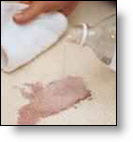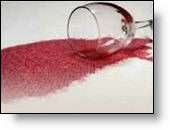Classification of stains
Knowing proper classification of stains can be a great help when facing the task of for example carpet cleaning. The reason for classification of stains is that different stains react to different carpet stain removal solutions differently. For example protein stains, dye stains, tannin, oil-based stains, they all react differently.Classification of stains and treatment
 The following is a list of classification of stains put together through many years of our carpet cleaning and carpeting products installation and maintenance experience. Some literature may have different approach to stains classification. This classification aims at providing at least one easy and effective method for cleaning spots using readily available consumer products, supplies, or stain removal chemicals. This classification of stains starts with stains which require similar treatment and are easiest to remove. Stains that require two-step or special treatment are listed lower on the list.
The following is a list of classification of stains put together through many years of our carpet cleaning and carpeting products installation and maintenance experience. Some literature may have different approach to stains classification. This classification aims at providing at least one easy and effective method for cleaning spots using readily available consumer products, supplies, or stain removal chemicals. This classification of stains starts with stains which require similar treatment and are easiest to remove. Stains that require two-step or special treatment are listed lower on the list.
Protein stain
Cleaning method: Protein stains should be soaked in cold water and then laundered. Fresh protein stains can be removed by soaking the soiled fabric in cold water before washing. If protein stains are dry and set, they should be soaked in cold water using a detergent or an enzyme presoak product. After treating the stain, the fabric should be laundered in warm (not hot) water. Bleach may be necessary if the stain was colored (beets, ice cream).Cleaning mistake: Protein stains should not be soaked in hot water. Soaking protein stains in hot water causes coagulation of the protein between the fibers of the yearn.
Example: baby food, baby formula, blood, cream, egg, feces, gelatin, cheese, ice cream, milk, mucous, mud, pudding, urine, vomit

Tannin stains
Cleaning method: To clean a tannin stain a detergent should be used (see clean stain). Soap should not be used on tannin stains. Fresh tannin stains usually can be removed using laundry detergent and by washing in hot water. Old and set tannin stains may need bleaching for more complete removal.Cleaning mistake: Soap should not be used on tannin stains. Using soap sets tannin stains permanent.
Example: alcoholic beverages, beer, coffee, cologne, color pen, cranberries, fruit juice (apple, grape, orange), raspberries, soft drinks, strawberries, tea, tomato juice, washable ink
Oil-based stains
Cleaning method: Oil-based stains are best treated with a heavy-duty detergent together with hot water. Heavy oil stains can be removed by pretreatment with a heavy-duty liquid detergent or with an aerosol petroleum-based solvent. On lighter stains, a powdered laundry detergent mixed with water to make a runny paste, and rubbing the stained fabric with that paste works too.Example: automotive oil, butter, collar/cuff greasy rings, cooking fats and oils, cream, fat, grease, hair oil, hand lotion, lard, margarine, mayonnaise, salad dressing, suntan oil or lotion
Dye stains
Cleaning method: Dye stains are very difficult to remove. Dye stains are best cleaned with heavy-duty detergent and safe-for-fabric bleach. First, dye stains need to be pretreated with a heavy-duty liquid detergent. Then, they need to be rinsed thoroughly. Finally, the fabric needs to be soaked in solution of all-fabric powdered bleach.Example: blueberry, grass, cherry, india ink, Kool-Aid, mustard, tempera paint
To have a clean carpet, it is necessary to apply correct cleaning methods.